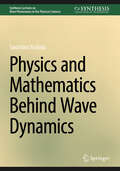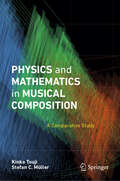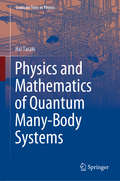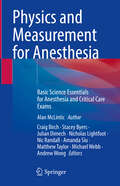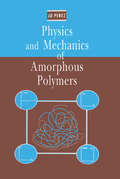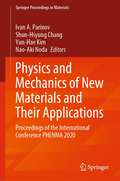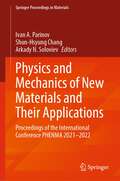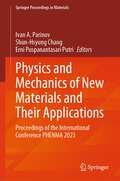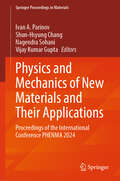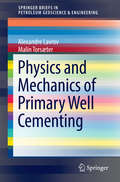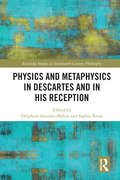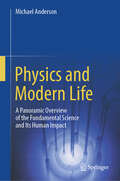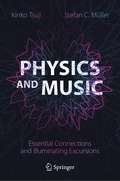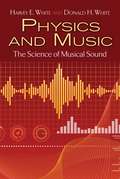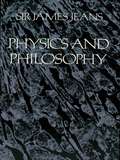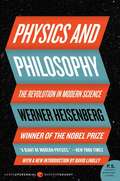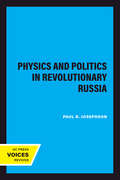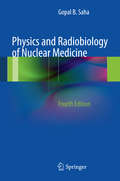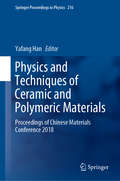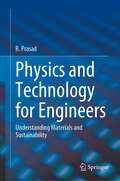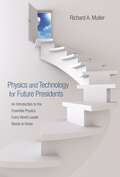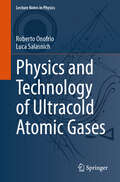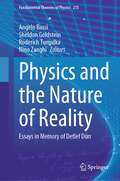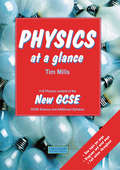- Table View
- List View
Physics and Mathematics Behind Wave Dynamics (Synthesis Lectures on Wave Phenomena in the Physical Sciences)
by Sanichiro YoshidaMost physical phenomena exhibit spatiotemporal features interpreted as wave dynamics. Various diagnostic technologies use some waves such as light, sound, and microwaves. A proper understanding of wave dynamics is essential to interpret these physical phenomena and apply the technology efficiently. However, the physics underlying the wave-like behavior of real-world systems is not necessarily straightforward. Often the mathematical description of these physics is hard to understand. Consequently, the interpretation of diagnostic signals is not simple, which sometimes leads to an incorrect diagnosis. This book aims to solve these problems by describing the related topics on a sound physical basis and explaining them intuitively for easy digestion. Presents real-world examples of oscillatory and wave systems to help the reader understand wave dynamics while explaining numerical methods. Explains the physics and mathematics underlying wave dynamics in intuitive fashions.
Physics and Mathematics in Musical Composition: A Comparative Study
by Stefan C. Müller Kinko TsujiHow is music born? Is music made by humans or does it already exist and wait to be found? How do composers create (or find) music? Having these questions in mind the authors ask more questions: How can we share our feelings with other people when listening to music? Can these be visualized? Why did Helmholtz have a problem with the third? Why is precise tuning so important in European music and less so in other cultures? What are the differences among the continents? What makes dissonant tone intervals uncomfortable in many cases? What enables us to distinguish the music of Mozart from that of Beethoven? Why are we fascinated by birdsong? Why does some music survive, whereas other just disappears? And finally, along which lines will music develop in the future? Drawing upon physics and mathematics, the authors search for answers to these questions and attempt to unravel in some depth the enigmas of how our minds are affected by the perception of music.
Physics and Mathematics of Quantum Many-Body Systems (Graduate Texts in Physics)
by Hal TasakiThis book is a self-contained advanced textbook on the mathematical-physical aspects of quantum many-body systems, which begins with a pedagogical presentation of the necessary background information before moving on to subjects of active research, including topological phases of matter. The book explores in detail selected topics in quantum spin systems and lattice electron systems, namely, long-range order and spontaneous symmetry breaking in the antiferromagnetic Heisenberg model in two or higher dimensions (Part I), Haldane phenomena in antiferromagnetic quantum spin chains and related topics in topological phases of quantum matter (Part II), and the origin of magnetism in various versions of the Hubbard model (Part III). Each of these topics represents certain nontrivial phenomena or features that are invariably encountered in a variety of quantum many-body systems, including quantum field theory, condensed matter systems, cold atoms, and artificial quantum systems designed for future quantum computers. The book’s main focus is on universal properties of quantum many-body systems. The book includes roughly 50 problems with detailed solutions. The reader only requires elementary linear algebra and calculus to comprehend the material and work through the problems. Given its scope and format, the book is suitable both for self-study and as a textbook for graduate or advanced undergraduate classes.
Physics and Measurement for Anesthesia: Basic Science Essentials for Anesthesia and Critical Care Exams
by Matthew Taylor Andrew Wong Michael Webb Craig Birch Stacey Byers Julian Dimech Nicholas Lightfoot Nic Randall Amanda SiuAnesthesia is a practical, clinically based medical science. Its conduct requires Anesthesiologists and Intensivists to learn and understand the principles of applied physics related to equipment responsible for the clinical care of patients. This book is written primarily for anesthetic registrars/residents and their teachers, to assist with preparation for the post graduate, basic science examinations in anesthesia and critical care medicine. Each topic is systematically covered using first principles, contextual examples, and illustrations to explain and demonstrate complex concepts. This comprehensive book is an up-to-date compilation of these scientific principles that can easily be applied to any operating theatre or intensive care unit around the world.
Physics and Mechanics of Amorphous Polymers
by Jo PerezTopics covered in this text include: structural aspects of polymers; molecular mobility in amorphous solid polymers; non-elastic deformation of solid amorphous polymers; mechanical experiments; interpretation of results; physical ageing of amorphous polymers; and glass transition.
Physics and Mechanics of New Materials and Their Applications: Proceedings of the International Conference PHENMA 2020 (Springer Proceedings in Materials #10)
by Shun-Hsyung Chang Ivan A. Parinov Yun-Hae Kim Nao-Aki NodaThis book presents selected peer-reviewed contributions from the 2020 International Conference on “Physics and Mechanics of New Materials and Their Applications”, PHENMA 2020 (26–29 March 2021, Kitakyushu, Japan), focusing on processing techniques, physics, mechanics, and applications of advanced materials. The book describes a broad spectrum of promising nanostructures, crystal structures, materials, and composites with unique properties. It presents nanotechnological design approaches, environmental-friendly processing techniques, and physicochemical as well as mechanical studies of advanced materials. The selected contributions describe recent progress in computational materials science methods and algorithms (in particular, finite-element and finite-difference modelling) applied to various technological, mechanical, and physical problems. The presented results are important for ongoing efforts concerning the theory, modelling, and testing of advanced materials. Other results are devoted to promising devices with higher accuracy, increased longevity, and greater potential to work effectively under critical temperatures, high pressure, and in aggressive environments.
Physics and Mechanics of New Materials and Their Applications: Proceedings of the International Conference PHENMA 2021-2022 (Springer Proceedings in Materials #20)
by Shun-Hsyung Chang Ivan A. Parinov Arkady N. SolovievThis book presents 50 selected peer-reviewed contributions from the 10th Anniversary International Conference on “Physics and Mechanics of New Materials and Their Applications”, PHENMA 2021-2022 (23-27 May, 2022, Divnomorsk, Russia), focusing on processing techniques, physics, mechanics, and applications of advanced materials. The book describes a broad spectrum of promising nanostructures, crystal structures, materials, and composites with unique properties. It presents nanotechnological design approaches, environmental-friendly processing techniques, and physicochemical as well as mechanical studies of advanced materials. The selected contributions describe recent progress in computational materials science methods and algorithms (in particular, finite-element and finite-difference modelling) applied to various technological, mechanical, and physical problems. The presented results are important for ongoing efforts concerning the theory, modelling, and testing of advanced materials. Other results are devoted to promising devices with higher accuracy, increased longevity, and greater potential to work effectively under critical temperatures, high pressure, and in aggressive environments.
Physics and Mechanics of New Materials and Their Applications: Proceedings of the International Conference PHENMA 2023 (Springer Proceedings in Materials #41)
by Shun-Hsyung Chang Ivan A. Parinov Erni Puspanantasari PutriThis book presents 60 selected peer-reviewed contributions from the international conference Physics and Mechanics of New Materials and Their Applications, PHENMA 2023 (3-8 October, 2023, Surabaya, Indonesia), focusing on processing techniques, physics, mechanics, and applications of advanced materials. The book describes a broad spectrum of promising nanostructures, crystal structures, materials, and composites with unique properties. It presents nanotechnological design approaches, environmental-friendly processing techniques, and physicochemical as well as mechanical studies of advanced materials. The selected contributions describe recent progress in energy harvesting and piezoelectric materials optimization, electromagnetoelastic actuators for nanotechnology research, impedance spectroscopy and study of ceramic materials, catalyst synthesis and control of morphological characteristics, synthesis and study of electrocatalysts for fuel cells. The presented results are important forongoing efforts concerning the theory, modelling, and testing of advanced materials. Other results are devoted to the analysis of technogenic raw materials and different material applications in science, technique and industry.
Physics and Mechanics of New Materials and Their Applications: Proceedings of the International Conference PHENMA 2024 (Springer Proceedings in Materials #3)
by Shun-Hsyung Chang Ivan A. Parinov Vijay Kumar Gupta Nagendra SohaniThe book provides new results of internationally recognized scientific teams in the fields of Materials Science, Physics, Mechanics, Fabrication Techniques and Technologies of Advanced Materials, operating in wide scaling from nanometer to macroscopic range. The developed theoretical and experiment approaches cover prospective manufacture methods of nanomaterials, ferroelectrics, piezoelectrics (environmentally friendly) and other advanced materials and composites. The book discusses fabrication techniques, physics, mechanics, and applications of promising materials and composites. It presents numerous results of theoretical and experimental studies of novel materials and devices with beforehand given and improved structure-sensitive properties, based on the methods of biology, inorganic and organic chemistry, magnetoelectric elasticity, physics of condensed matter and material science. Thus, the book allows one to better understand the modern requirements for advanced materials and composites. The results obtained also include computational algorithms and original hard- and software, used in realization of numerical methods (in particular, finite-element modeling), demonstrating fascinating new advancements for wide spectrum of novel materials (which could be obtained due to reprocessing or using natural materials, wastes, fruits and plants) and devices. The advanced materials with specific properties and novel devices, based on them, show higher and improved properties in comparison with the properties of the competitive publications. In the result, it gives a new knowledge, which is necessary for numerous applications and subsequent development of industry and the methods of management and marketing. The original theoretical, numerical and experiment methods, manufactured devices and set-ups demonstrate significant possibilities in expanding the research of various physical processes and phenomena. They provide different improvements in the study of numerous structure-sensitive characteristics of solids and structures. The book will be useful for students, post-graduate students, scientists and engineers, which research and develop a new generation of nanomaterials and nanocomposites, ferroelectric and piezoelectric materials, other promising structures and compositions with structure-sensitive properties, and various devices, designed on their base and used in different applications of science, technique and technology. Moreover, it will be very interesting for specialists, working in industry, management and marketing. The book is important for unification and development of various expertise, designs and studies. It presents new research methods and scientific results in the Condensed Matter Physics, Materials Science, Physical and Mechanical Experiment, Processing Techniques and Engineering of Nanomaterials, Piezoelectrics and other Advanced Materials and Composites, Computational Methods, numerous applications and developed devices.
Physics and Mechanics of Primary Well Cementing
by Alexandre Lavrov Malin TorsæterThis book covers the major physical and mechanical processes that unfold during cementing and subsequent well service, and which can affect the well integrity. Focusing on the underlying physics, it concisely presents the central concepts of well cementing. The authors discuss the displacement of different fluids in the annulus, the mechanical stability of cement subject to varying downhole temperature, pressure and in-situ stresses, and the impact of defects on cement integrity under different mechanical and thermal loads over the course of the well's lifetime. The book identifies knowledge gaps and unresolved issues, and proposes new directions for future research and development. The book is a valuable resource for practising engineers in the oil and gas industry, academic and industrial researchers involved in oil and gas engineering, and to graduate students within this same sector.
Physics and Metaphysics in Descartes and in his Reception (Routledge Studies in Seventeenth-Century Philosophy)
by Sophie Roux Delphine Antoine-MahutThis volume explores the relationship between physics and metaphysics in Descartes’ philosophy. According to the standard account, Descartes modified the objects of metaphysics and physics and inverted the order in which these two disciplines were traditionally studied. This book challenges the standard account in which Descartes prioritizes metaphysics over physics. It does so by taking into consideration the historical reception of Descartes and the ways in which Descartes himself reacted to these receptions in his own lifetime. The book stresses the diversity of these receptions by taking into account not only Cartesianisms but also anti-Cartesianisms, and by showing how they retroactively highlighted different aspects of Descartes’ works and theoretical choices. The historical aspect of the volume is unique in that it not only analyzes different constructions of Descartes that emerged in the 18th, 19th and 20th centuries, but also reflects on how his work was first read by philosophers across Europe. Taken together, the essays in this volume offer a fresh and up-to-date contribution to this important debate in early modern philosophy.
Physics and Modern Life: A Panoramic Overview of the Fundamental Science and Its Human Impact
by Michael AndersonThis book introduces physics concepts and principles at a conversant but non-technical level. It also explores technology, with particular focus on two overarching themes that largely define modern life: our intensified use of energy and digital information. These themes take up several entire chapters (“Human Use of Chemical Fuel,” “Computers,” and “Light and Telecommunications”) and substantial parts of several others (e.g., sections on satellites and GPS, telegraph and telephone networks, generators and transformers, nuclear power, and solid-state technologies). The themes of energy and information highlight the pertinence of physics and facilitate a big-picture understanding of how life today differs from that of two hundred or two thousand years ago. The book grew out of lecture notes for a one-semester college physics course for non-science majors, so it could be useful to instructors and students of similar courses. The abundance of material offers some freedom in the design of such a course. However, the author hopes that the combination of conceptual depth and informal tone will appeal to a more diverse audience united by a genuine curiosity regarding science and technology. That audience might include pursuers of continuing education as well as physics majors looking for a lighter conceptual supplement to give context to their more technical coursework.
Physics and Music: Essential Connections and Illuminating Excursions
by Stefan C. Müller Kinko TsujiThis book explores the fascinating and intimate relationship between music and physics. Over millennia, the playing of, and listening to music have stimulated creativity and curiosity in people all around the globe. Beginning with the basics, the authors first address the tonal systems of European-type music, comparing them with those of other, distant cultures. They analyze the physical principles of common musical instruments with emphasis on sound creation and particularly charisma. Modern research on the psychology of musical perception – the field known as psychoacoustics – is also described. The sound of orchestras in concert halls is discussed, and its psychoacoustic effects are explained. Finally, the authors touch upon the role of music for our mind and society. Throughout the book, interesting stories and anecdotes give insights into the musical activities of physicists and their interaction with composers and musicians.
Physics and Music: The Science of Musical Sound (Dover Books on Physics)
by Donald H. White Harvey E. WhiteThis foundational text is written for students who want to go beyond the perceptual stage of music to learn how musical sound is created and perceived. It surveys a wide range of topics related to acoustics, beginning with a brief history of the art and science of music. Succeeding chapters explore the general principles of sound, musical scales, the primary ways in which sound can be generated, the characteristics of instruments, the use of mechanical and electronic recording devices, hi-fi stereophonic and quadraphonic sound, the design of electronic musical instruments, and architectural acoustics.Comprehensive yet accessible, Physics and Music includes over 300 diagrams, photographs, and tables. Each chapter concludes with questions, problems, and projects, in addition to references for further study. 1980 edition.
Physics and Philosophy
by James JeansCan we have any knowledge of the world outside us other than we gain by the methods of science? Are we humans endowed with free will, or are we mere cogs in a vast machine that must follow its predestined course until it finally runs down? Is the world we perceive the world of ultimate reality, or is it only a curtain veiling a deeper reality beyond?In this strikingly lucid and often poetic book, one of the twentieth century's greatest scientists grapples with these age-old questions, achieving in the process a brilliant and non-technical exposition of the interrelationship between physics and philosophy. He begins by defining physics and philosophy, pointing out the difference in their respective attempts to explain physical reality and man's place in it. This discussion paves the way for an outline of epistemological methods in which the rationalism of thinkers like Descartes, Leibniz, and Kant is compared to the empiricism of Locke and Hume.Over the course of the book, in a manner that is careful and methodic but never dull, Jeans marshals the evidence for his startling conclusion: recent discoveries in astronomy, mathematics, sub-atomic physics, and other disciplines have washed away the scientific basis of many older philosophic discussions. Such long-standing problems as causality, free will and determinism, the nature of space and time, materialism and mentalism must be considered anew in the light of new knowledge and information attained by twentieth-century physical science. Even then, however, Jeans cautions against drawing any positive conclusions, pointing out that both physics and philosophy are both relatively young and that we are still in Newton's words, like children playing with pebbles on the sea-shore, while the great ocean of truth rolls, unexplored, beyond our reach.Although first published in 1943, nothing in physics has happened to affect Jeans's account in this book; it remains remarkably fresh and undated, a classic exposition of the philosophical implications of scientific knowledge.
Physics and Philosophy
by Werner HeisenbergThe seminal work by one of the most important thinkers of the twentieth century, Physics and Philosophy is Werner Heisenberg's concise and accessible narrative of the revolution in modern physics, in which he played a towering role. The outgrowth of a celebrated lecture series, this book remains as relevant, provocative, and fascinating as when it was first published in 1958. A brilliant scientist whose ideas altered our perception of the universe, Heisenberg is considered the father of quantum physics; he is most famous for the Uncertainty Principle, which states that quantum particles do not occupy a fixed, measurable position. His contributions remain a cornerstone of contemporary physics theory and application.
Physics and Philosophy: Philosophical Papers Volume 4
by Joseph Agassi Stefano Gattei Paul K. FeyerabendThis collection of the writings of Paul Feyerabend is focused on his philosophy of quantum physics, the hotbed of the key issues of his most debated ideas. Written between 1948 and 1970, these writings come from his first and most productive period. These early works are important for two main reasons. First, they document Feyerabend's deep concern with the philosophical implications of quantum physics and its interpretations. These ideas were paid less attention in the following two decades. Second, the writings provide the crucial background for Feyerabend's critiques of Karl Popper and Thomas Kuhn. Although rarely considered by scholars, Feyerabend's early work culminated in the first version of Against Method. These writings guided him on all the key issues of his most well-known and debated theses, such as the incommensurability thesis, the principles of proliferation and tenacity, and his particular version of relativism, and more specifically on quantum mechanics. Feyerabend is one of the most important contemporary philosophers of science: his work continues to be discussed and his provocative style still challenges philosophers nowadays. Provides the first comprehensive picture of Feyerabend's works on the philosophy of physics. Makes available in English, for the first time, a few key works which were originally published in German, as well as an unpublished article. The papers originally published in English are not always readily available to scholars
Physics and Politics in Revolutionary Russia (California Studies in the History of Science #7)
by Paul R. JosephsonAided by personal documents and institutional archives that were closed for decades, this book recounts the development of physics—or, more aptly, science under stress—in Soviet Russia up to World War II. Focusing on Leningrad, center of Soviet physics until the late 1930s, Josephson discusses the impact of scientific, cultural, and political revolution on physicists' research and professional aspirations.Political and social revolution in Russia threatened to confound the scientific revolution. Physicists eager to investigate new concepts of space, energy, light, and motion were forced to accommodate dialectical materialism and subordinate their interests to those of the state. They ultimately faced Stalinist purges and the shift of physics leadership to Moscow. This account of scientists cut off from their Western colleagues reveals a little-known part of the history of modern physics.
Physics and Radiobiology of Nuclear Medicine
by Gopal B. SahaThe Fourth Edition of Dr. Gopal B. Saha's Physics and Radiobiology of Nuclear Medicine was prompted by the need to provide up-to-date information to keep pace with the perpetual growth and improvement in the instrumentation and techniques employed in nuclear medicine since the last edition published in 2006. Like previous editions, the book is intended for radiology and nuclear medicine residents to prepare for the American Board of Nuclear Medicine, American Board of Radiology, and American Board of Science in Nuclear Medicine examinations, all of which require a strong physics background. Additionally, the book will serve as a textbook on nuclear medicine physics for nuclear medicine technologists taking the Nuclear Medicine Technology Certification Board examination. The Fourth Edition includes new or expanded sections and information for: * PET/MR, including the attenuation correction method and its quality control tests; * accreditation of nuclear medicine and PET facilities; * solid state digital cameras; * time of flight and scatter correction techniques; * CT scanners and attenuation correction in SPECT/CT; * partial volume effects; * quality control of CT scanners; * ion chamber survey meters, proportional counters, and G-M counters.
Physics and Techniques of Ceramic and Polymeric Materials: Proceedings of Chinese Materials Conference 2018 (Springer Proceedings in Physics #216)
by Yafang HanThis book gathers selected papers from the Chinese Materials Conference 2018 (CMC2018) held in Xiamen City, Fujian, China, on July 12–16, 2018. The Chinese Materials Conference (CMC) is the Chinese Materials Research Society’s most important conference series and has been held annually since the early 1990s. The 2018 edition consisted of 32 domestic symposia, 2 international symposia and 1 international materials forum. This proceedings book covers the fields of advanced ceramic materials and polymer materials, and presents recent original research results from more than 300 research groups in various universities and research institutes.
Physics and Technology for Engineers: Understanding Materials and Sustainability
by R. PrasadThis textbook covers the physics of engineering materials and the latest technologies used in modern engineering projects. It has been designed for use as a reference book and course material for undergraduate engineering students. The book was born out of the need for a comprehensive, balanced, and up-to-date guide for teaching physics to beginning undergraduate engineering students and creating examination papers for technical boards and institutes. The text is divided into ten chapters, each with its specific objectives and features. The topics covered include the classification of engineering materials, atomic structure, electrical and magnetic behavior of solids, quantum mechanics, laser technology, nanomaterials, and sustainable development.Authored by a physicist with over 40 years of teaching experience, this richly-illustrated textbook features an abundance of self-assessment questions, solved examples, and a variety of chapter-end questions with detailed answers. The textbook starts from the very basics and is developed to the desired level, thus making it ideal as standalone course material.
Physics and Technology for Future Presidents: An Introduction to the Essential Physics Every World Leader Needs to Know
by Richard A. MullerPhysics for future world leadersPhysics and Technology for Future Presidents contains the essential physics that students need in order to understand today's core science and technology issues, and to become the next generation of world leaders. From the physics of energy to climate change, and from spy technology to quantum computers, this is the only textbook to focus on the modern physics affecting the decisions of political leaders and CEOs and, consequently, the lives of every citizen. How practical are alternative energy sources? Can satellites really read license plates from space? What is the quantum physics behind iPods and supermarket scanners? And how much should we fear a terrorist nuke? This lively book empowers students possessing any level of scientific background with the tools they need to make informed decisions and to argue their views persuasively with anyone—expert or otherwise.Based on Richard Muller's renowned course at Berkeley, the book explores critical physics topics: energy and power, atoms and heat, gravity and space, nuclei and radioactivity, chain reactions and atomic bombs, electricity and magnetism, waves, light, invisible light, climate change, quantum physics, and relativity. Muller engages readers through many intriguing examples, helpful facts to remember, a fun-to-read text, and an emphasis on real-world problems rather than mathematical computation. He includes chapter summaries, essay and discussion questions, Internet research topics, and handy tips for instructors to make the classroom experience more rewarding.Accessible and entertaining, Physics and Technology for Future Presidents gives students the scientific fluency they need to become well-rounded leaders in a world driven by science and technology.Leading universities that have adopted this book include:HarvardPurdueRice UniversityUniversity of ChicagoSarah Lawrence CollegeNotre DameWellesleyWesleyanUniversity of ColoradoNorthwesternWashington University in St. LouisUniversity of Illinois - Urbana-ChampaignFordhamUniversity of MiamiGeorge Washington UniversitySome images inside the book are unavailable due to digital copyright restrictions.
Physics and Technology of Ultracold Atomic Gases (Lecture Notes in Physics #1034)
by Luca Salasnich Roberto OnofrioThis book is based on lecture notes originally developed for introductory graduate courses offered by the authors at Dartmouth College and the University of Padova. The first two chapters analyze quantum degenerate gases and various cooling and trapping techniques for atoms. The remaining three chapters discuss ultracold atoms as weakly interacting, strongly interacting, and non-interacting coherent systems. The third chapter presents multiple pieces of evidence for quantum degeneracy in Bose and Fermi gases, followed by peculiar features such as superfluidity and the formation of topological defects. The fourth chapter addresses strongly correlated systems, discussing the BCS-BEC crossover in fermionic gases and quantum phase transitions, including their dependence on effective dimensionality. The fifth chapter offers a more specific discussion of quantum coherence in ultracold atoms and their potential as a platform for quantum metrology and quantum emulation. Four appendices provide more quantitative details of theoretical tools used in the last two chapters. Each chapter concludes with problems and a list of more specialized material. The main goal is to introduce interested students to ultracold atom physics research topics and expose scientists working in other areas of frontier physics to this novel and exciting research direction. This book is also intended to complement existing textbooks in standard courses on condensed matter physics, demonstrating how some general elements of the latter can be understood by continuously increasing the interactions between ultracold and quantum degenerate atoms under controlled external conditions.
Physics and the Nature of Reality: Essays in Memory of Detlef Dürr (Fundamental Theories of Physics #215)
by Angelo Bassi Roderich Tumulka Sheldon Goldstein Nino ZanghìThis volume commemorates the scientific contributions of Detlef Dürr (1951–2021) to foundational questions of physics. It presents new contributions from his former students, collaborators, and colleagues about their current research on topics inspired or influenced by Dürr. These topics are drawn from physics, mathematics, and philosophy of nature, and concern interpretations of quantum theory, new developments of Bohmian mechanics, the role of typicality, quantum physics in relativistic space-time, classical and quantum electrodynamics, and statistical mechanics. The volume thus also gives a snapshot of present research in the foundations of physics.
Physics at a Glance: Full Physics Content of the New GCSE
by Tim MillsThis book aims to cover all the GCSE Physics material needed to meet the specifications of the examining boards Edexcel, AQA, WJEC and OCR (both 21st Century Science and Gateway) both for single and double awards. The content also covers the additional topics necessary for the Physics GCSE single award. It is the third book in the series following
